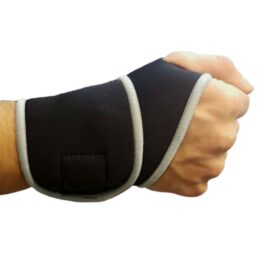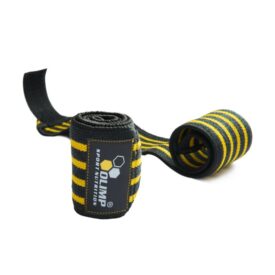From footballers to weightlifters, dancers to cricketers & gymnasts to darts players. A sprained wrist is one of the most common injuries around, the sprained wrist can occur from many things, such as falling on an outstretched hand. No matter how much of a seasoned veteran you are at your sport or fitness routine, you are only one momentary lapse of concentration away from a world of pain.
In this blog post, we’re going to be looking at how you can potentially cause injury to your wrist and the tissue that connects the bones. We will also review how to treat a sprained wrist and preventative measures you can take to avoid this type of injury.
Sprained Wrist Causes
OrthoInfo state that a sprained wrist occurs when the ligaments that connect/support the wrist are stretched beyond their capabilities or torn. Which typically occurs when your wrist is bent or twisted, such as falling. The injury can range from extremely mild pulsation to excruciating pain, depending on how badly the ligaments in your wrist are damaged.
Wrist sprains are generally categorised into 3 grades.
- Grade One is the mildest form of a wrist sprain (with the least amount of pain), this is when the ligaments are stretched but not torn.
- Grade Two is when the pain ramps up a bit. Grade Two sprains are when the ligaments are torn, partially – this may including limiting your function & range of motion in your wrist.
- Grade Three is when things start to get bad. When you have a Grade Three sprain, that means the ligament in the wrist is either torn completely or removed from the bone. Since this is the most severe grade of sprain, it is important that you see a medical professional immediately. This is because if the ligament tears away from your bone, it may take a small piece of the bones in your wrist with it and give you avulsion wrist fracture.
Sprained Wrist Symptoms
Not only will you feel pain with a sprained wrist but you might also encounter swelling, bruising & tenderness to touch. You may also experience a feeling of warmth, popping & tearing.
Undiagnosed, a sprained wrist can lead to long term problems. Even if the pain is tiny with a very small amount of swelling, it could still be a torn ligament and if left untouched, may require corrective surgery in the future.
Sometimes, it may prove difficult to identify the difference between sprains and fractures, so it is important to show it to a medical professional at the earliest opportunity. Incorrectly identifying your injury as a sprain when it could well be a fracture may result in worst cases, a surgical procedure if left untreated.
Sprained Wrist Treatment
Treating a sprained wrist can vary from a few days rest to a long recovery.
Typically, mild wrist sprains can be treated at home using the RICE method, which is:
- Rest – If you suspect that you have sprained your wrist, leave it resting for a minimum of 48 hours.
- Ice – Apply an ice pack to the affected area immediately after injury, it will keep the swelling down. It is recommended that you use cold/ice packs multiple times a day for 20 minutes at a time. Do not apply ice directly to the skin.
- Compression – Wearing things such as elasticated compression bandages help reduce the swelling around the wrist.
- Elevation – Keeping your wrist above your heart is also a good way for your wrist to keep getting the blood flow, try and keep your wrist above your heart as much as possible.
There are other ways to keep the pain and swelling down without these methods.
Non-steroidal anti-inflammatory’s like ibuprofen or aspirin help reduce swelling & pain. If after 48 hours you still have swelling and pain, it is then recommended you see a doctor.
How long does a sprained wrist take to heal?
All wrist sprains are different, depending on the severity of the sprain, it can take anywhere from a few days for a mild sprain, to roughly 10 weeks for a more severe sprain, or even several months for repair after surgery.
IF YOU HAVE A MODERATE SPRAINED WRIST – GRADE 1 & 2
Your doctor might give you something like a wrist splint. This is to immobilize it so it can begin the healing process. However, you will have to take it out once in a while and stretch it, so it doesn’t become stiff – the doctor should give you some exercises if you ask.
IF YOU HAVE A SEVERELY SPRAINED WRIST – GRADE 3
Surgery may be required for this level of a wrist sprain, which could involve reconnecting your damaged ligament to the bone or even using a tendon graft to recreate your damaged ligament.
Once you have finished surgery, you will have a rehab period which will be exercises that will strengthen the wrist and increase its range of motion. You can feel the recovery in 8 to 12 weeks but full recovery can last up to 12 months, depending on the severity of the injury.
- The most important thing to remember is to give your wrist time to heal, don’t try to use the wrist as normal straight away. You will know the healing process is finished when you:
- No longer feel pain in your wrist
- There is no swelling or tenderness to your wrist
- You no longer need to take pain relief to move your wrist
- Can perform normal duties without worrying about your wrist being injured further
Sprained Wrist Prevention
A wrist sprain is difficult to prevent fully, as most are caused by accidents or unforeseen scenarios. However, there are some prevention methods for certain activities and sports where we know we will be straining or using our wrist a lot.
In terms of weightlifting, whether it be with dumbbells or weighted plates and bars, wrists are under a lot of strain. First of all, don’t lift more than you can handle, the second is to review how you use your wrist when lifting. Sometimes the curl of our wrist when lifting can affect how the weight compounds on our ligaments, try keeping your wrist movement straight in line with your arm and lift with your biceps to reduce risk of soreness.
Fast repetitive movement of any joint can cause swelling and pain, this is the same for lifting, reps should be lifted at a medium to slow pace, not rushed to get the weights done as fast as possible.
Wearing wrist wraps are a brilliant way to support your wrist when lifting often or lifting heavy loads. CrossfitInvictus say that you should only wear wraps for anything more than 60% of your 1-RM (Repetition Max) press.
For full wrist wraps and wrist straps see our workout accessories section, we have a variety of colours, sizes & different resistance that will suit your needs.
Wrist Wraps & Support
Strengthening your wrist and forearms are another great way to prevent wrist sprain, this can be done by stretching and exercising the fingers and wrists. Our hand grip exerciser can help build strength in this area. With a counter or without a counter is the big question, though. SS Healthfoods Wrist Support is also a great way to protect yourself against any unwanted injuries.
A wrist sprain can be annoying and inconvenient but with the correct precautions and or treatment, it shouldn’t be something that causes permanent damage or affect the rest of your life.





